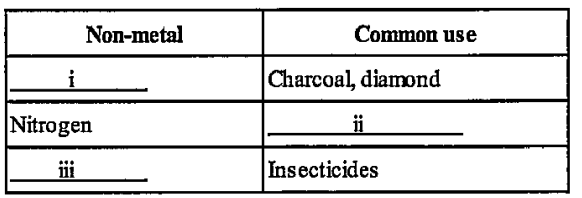The given table enlists various types of secondary metabolites and their examples.
Type of the metaboliteExampleAlkaloids(i)______Terpenoides(ii)_____Toxins(iii)_____PolymersCellulose
The information in which alternative completes the given table ?
i-Morphine, ii-Curcumin, iii-Anthocyanin
i-Vinblastin, ii-Curcumin, iii-Abrin
i-Vinblastin, ii-Deterpenes, iii-Anthocyanin
i-Morphine, ii-Diterpenes, iii-Abrin
The correct Answer is:D
To complete the given table of secondary metabolites and their examples, we will identify appropriate examples for each type of metabolite listed.
1. Identify the Types of Secondary Metabolites: The types listed in the table are Alkaloids, Terpenoids, Toxins, and Polymers.
2. Find Examples for Each Type:
- Alkaloids: Common examples include nicotine, caffeine, morphine, and cocaine. For this table, we can use morphine as an example.
- Terpenoids: Examples include menthol, limonene, and dieterpenes. We can use dieterpenes as an example.
- Toxins: Examples include ricin and abrin. We can use ricin as an example.
- Polymers: The example given is cellulose, which is correct.
3. Fill in the Table:
- For Alkaloids: (i) morphine
- For Terpenoids: (ii) dieterpenes
- For Toxins: (iii) ricin
- For Polymers: Cellulose (already provided)
4. Final Table:
| Type of the metabolite | Example |
|------------------------|----------------|
| Alkaloids | morphine |
| Terpenoids | dieterpenes |
| Toxins | ricin |
| Polymers | Cellulose |
- Alkaloids: Common examples include nicotine, caffeine, morphine, and cocaine. For this table, we can use morphine as an example.
- Terpenoids: Examples include menthol, limonene, and dieterpenes. We can use dieterpenes as an example.
- Toxins: Examples include ricin and abrin. We can use ricin as an example.
- Polymers: The example given is cellulose, which is correct.
- For Alkaloids: (i) morphine
- For Terpenoids: (ii) dieterpenes
- For Toxins: (iii) ricin
- For Polymers: Cellulose (already provided)
| Type of the metabolite | Example |
|------------------------|----------------|
| Alkaloids | morphine |
| Terpenoids | dieterpenes |
| Toxins | ricin |
| Polymers | Cellulose |
Similar Questions
Knowledge Check
The given table enlists various hormones and their chemical nature. Select the option which completes the table
 A(i)(ii)(iii)(iv)CortisolSteroidPolypeptideEstradiolB(i)(ii)(iii)(iv)OxytocinProteinlodothyronineEpinephrineC(i)(ii)(iii)(iv)CortisolProteinAmineEstradiolD(i)(ii)(iii)(iv)OxytocinSteroidlodothyronineEpinephrine
A(i)(ii)(iii)(iv)CortisolSteroidPolypeptideEstradiolB(i)(ii)(iii)(iv)OxytocinProteinlodothyronineEpinephrineC(i)(ii)(iii)(iv)CortisolProteinAmineEstradiolD(i)(ii)(iii)(iv)OxytocinSteroidlodothyronineEpinephrineThe given table represents the use of non- metal.

The information in which row completes the given table?AI-Carbon, ii-freezing food, iii- sulphurBI-Sulphur, ii-kitchen foil, iii-zineCI-Carbon, ii-kitchen foil, iii-zincDI-Sulphur, ii-freezing food, iii-carbonThe given table enlists various plant hormones and their functions.

The information in which alternative completes the given table?Ai-Gibberellic acid, ii-Abscisic acidBi-Abscisic acid, ii-AuxinCi-Auxin, ii-EthyleneDi-Ethylene, il-Gibberellic acid
_____i__________and ___________ii_______are parts of the stamen. The information in which alternative completes the given statement?
View SolutionI. 2.4 CM = i– mm
II. 3.1 mm = ii–– km
The information in which alternative completes the given statement?
View Solution____i____and___ii_________are plants which have unisexual flowers. The information in which alternative completes the given statement?
View Solutioni breeze blows during the ii from the land to the sea.
The information in which alternative completes the given statement?
View SolutionThe _i_ present on the ____ii____. of plants help in the exchange of gases. The information in which alternative completes the given statement?
View Solution
